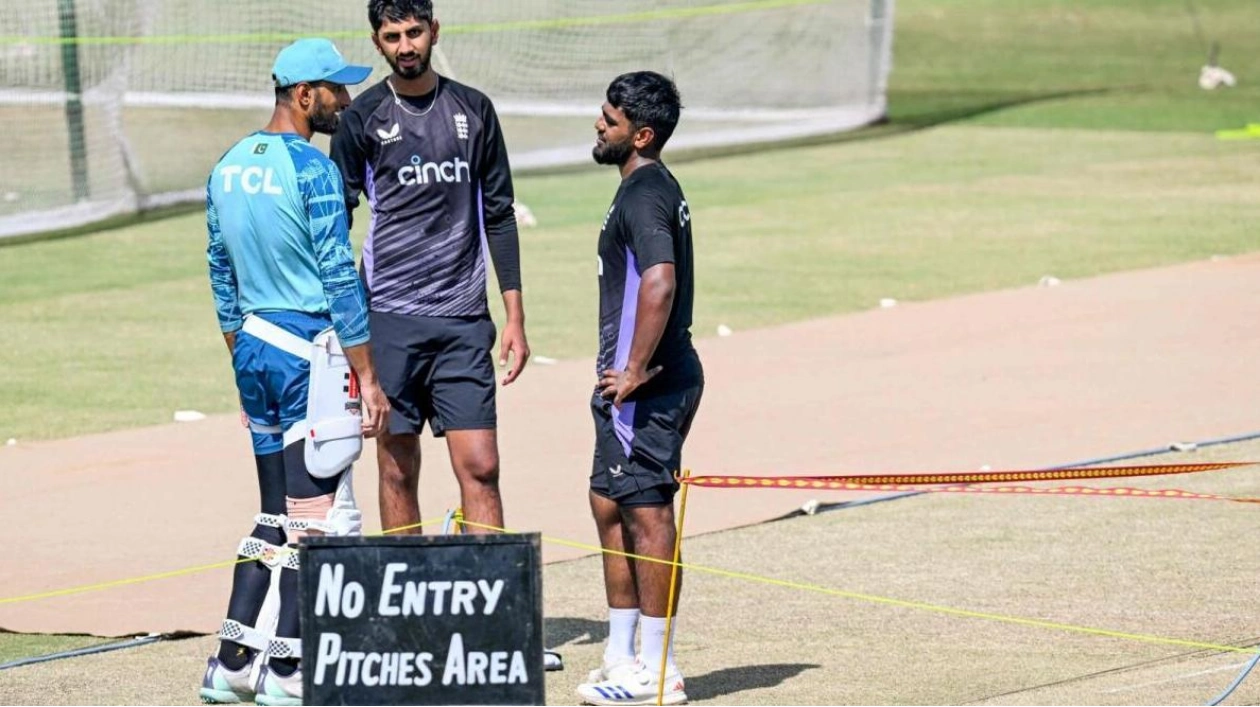Pakistan's captain Shan Masood (left) alongside England's Shoaib Bashir (centre) and Rehan Ahmed inspect the pitch during a practice session ahead of their second Test cricket match at the Multan Cricket Stadium in Multan on Sunday. — AFP
Australia's pace legend Dennis Lillee once described a pitch in Pakistan as a 'graveyard for bowlers' in 1980, and over four decades later, the situation remains largely unchanged. Lillee expressed his frustration after enduring 21 wicketless overs in Faisalabad, resulting in a tedious draw. All 11 Australian players, including wicketkeeper Rod Marsh, took turns bowling in Pakistan's second innings of 382-2, which followed Australia's 617 all out, as the match descended into near farce. Last week, on a pitch dubbed 'a road' by former captain Michael Vaughan, England set new records by scoring 823-7 declared in response to Pakistan's 556 in the first Test in Multan. This total was the fourth highest in Test history. Harry Brook scored 317 at nearly a run per ball, and Joe Root became England's highest Test run scorer with his career-best 262. Their partnership of 454 for the fourth wicket was an England record, the fourth highest in history, and the most by any pair playing overseas. Despite the lifeless pitch, England's bowlers secured an innings and 47-run victory after Pakistan collapsed to 220 all out in their second innings. This marked Pakistan's first-ever Test loss by an innings after scoring 500 or more. England batting great Kevin Pietersen criticized the lack of assistance for bowlers in Multan, where the second Test begins on Tuesday, stating it was 'helping destroy Test cricket'. 'It's a perennial problem,' said former Pakistan captain Wasim Akram. 'For years, we've had the same old story. Very rarely did we get green and lively pitches in the 1990s; we had to bowl long spells for wickets.' Rashid Latif, a former Pakistan captain and pitch preparation expert, believes there's no need for pitches to be overwhelmingly in favor of batsmen. 'We can prepare good pitches, but our mindset is negative,' Latif told AFP. 'There was good grass on the Multan pitch, but it was shaved off, I don't know on whose wishes.' Former spinner and ex-selector Tauseef Ahmed, who played in the infamous 1980 Faisalabad Test, noted, 'Our batters want a flat pitch to score runs.' Even in domestic matches, we have such pitches so that players score big and gain prominence.' In the past two years, Pakistan's pitches have become even more docile, with each Test wicket now costing an average of 42.13 runs, the highest in the world. Pitch preparation is a science, with experts recommending a soil mix of around 60% clay and less sand, similar to that found in Australia. This produces firm and bouncy tracks that gradually take more spin over five days, providing a balance between ball and bat. A local groundsman highlighted the challenges in Pakistan. 'There are multiple factors, from weather to interference from the team management who want it to suit them,' said the curator, who wished to remain anonymous. 'A good pitch needs sun to bake it, but in some weather, we don't get that,' he explained. 'A Test pitch needs to be cared for six months or a year, but our pitches are over-used, so they become flat.' Latif emphasized the need for serious efforts to improve pitch standards. 'There should be a research department under a good geologist to determine how a good pitch can be prepared,' Latif suggested. He also advocated for the use of balls with a more prominent seam to aid bowlers, such as Grays, Duke, or SG balls, which are hand-stitched. Two years ago, Pakistan and Australia combined for 1,187 runs with just 14 wickets taken in a dull draw in Rawalpindi. Then Pakistan cricket chief Ramiz Raja criticized the playing surface: 'We live in the dark ages of pitches in Pakistan. This is not a good advertisement for Test cricket.' With the second Test starting in Multan on Tuesday and the third in Rawalpindi next week, it appears unlikely that bowlers will find any relief soon.






